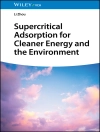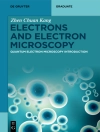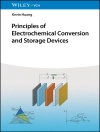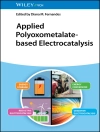The book sets the standard on carbon materials for electrode design. For the first time, the leading experts in this field summarize the preparation techniques and specific characteristics together with established and potential applications of the different types of carbon-based electrodes. An introductory chapter on the properties of carbon together with chapters on the electrochemical characteristics and properties of the different modifications of carbon such as carbon nanotubes, graphene, carbon fiber, diamond or highly ordered pyrolytic graphite provide the reader with the basics on this fascinating and ubiquitous electrode material. Cutting-edge technologies such as carbon electrodes in efficient supercapacitors, Li-ion batteries and fuel cells, or electrodes prepared by screen-printing are discussed, giving a complete but concise overview about the topic. The clearly structured book helps newcomers to grasp easily the principles of carbon-based electrodes, while researchers in fundamental and applied electrochemistry will find new ideas for further research on related key technologies.
表中的内容
List of Contributors XIII
Series Editors Preface XIX
Preface XXI
1 Properties of Carbon: An Overview 1
Shengxi Huang, Johan Ek Weis, Sara Costa, Martin Kalbac, and Mildred S. Dresselhaus
1.1 Overview of Properties 1
1.2 Different Forms of Carbon 2
1.2.1 Graphene 2
1.2.1.1 Optical Properties 2
1.2.1.2 Electrical Properties and Tunability 4
1.2.1.3 Spectroscopic Properties 5
1.2.2 HOPG 11
1.2.3 Carbon Nanotube 12
1.2.3.1 Structure and Electronic Properties 12
1.2.3.2 Spectroscopy and Spectroelectrochemistry of Carbon Nanotubes 14
1.2.4 Graphene Nanoribbon 18
1.2.5 Diamond 20
1.2.6 Porous Carbon 20
1.3 Outlook 21
References 21
2 Electrochemistry at Highly Oriented Pyrolytic Graphite (HOPG): Toward a New Perspective 31
Aleix G. Güell, Sze-yin Tan, Patrick R. Unwin, and Guohui Zhang
2.1 Introduction 31
2.2 Structure and Electronic Properties of HOPG 33
2.2.1 Structure and Formation 33
2.2.2 Electronic Properties 39
2.2.3 Implications for Electrochemical Studies 44
2.3 Formative Studies of HOPG Electrochemistry 45
2.3.1 Early Macroscopic Voltammetric Measurements and Correlations 45
2.3.2 Macroscopic Voltammetry and Modeling 49
2.3.3 Alternating Current (AC) Voltammetric Methods 50
2.3.4 Critical Comparison of Macroscopic Data 50
2.4 Microscopic Views of Electrochemistry at HOPG 53
2.4.1 Outer-Sphere Redox Systems 53
2.4.1.1 Scanning Micropipette Contact Method 53
2.4.1.2 Nafion Film-Covered HOPG 55
2.4.1.3 Scanning Electrochemical Cell Microscopy (SECCM) 56
2.4.1.4 Scanning Electrochemical Microscopy (SECM) 60
2.4.1.5 SECM–AFM Studies 61
2.4.1.6 Recent Macroscopic Studies 62
2.4.2 Complex Multistep Reactions: Neurotransmitter Oxidation 64
2.4.3 Adsorbed Systems 68
2.4.4 Diazonium Functionalization of HOPG 71
2.5 Conclusions 73
Acknowledgments 75
References 75
3 Electrochemistry in One Dimension: Applications of Carbon Nanotubes 83
Emiliano N. Primo, Fabiana Gutiérrez, Mar´?Ya D. Rubianes, Nancy F. Ferreyra, Marcela C. Rodr´?Yguez, Mar´?Ya. L. Pedano, Aurelien Gasnier, Alejandro Gutierrez, Marcos Egu´?Ylaz, Pablo Dalmasso, Guillermina Luque, Soledad Bollo, Concepción Parrado, and Gustavo A. Rivas
3.1 Carbon Nanotubes: General Considerations 83
3.2 Structure and Synthesis of CNTs 84
3.3 Structure of CNTs versus Electrochemical Properties 86
3.4 Strategies for the Preparation of Carbon Nanotube-Based Electrodes 89
3.4.1 Functionalization 89
3.4.1.1 Covalent Functionalization 90
3.4.1.2 Noncovalent Functionalization 90
3.4.2 Preparation of Carbon Nanotube Paste Electrodes Using Different Binders 106
3.4.2.1 Screen-Printed Electrodes (SPE) 108
3.5 Prospective Work 108
References 109
4 Electrochemistry of Graphene 121
Hollie V. Patten, Mat??ej Velick´y, and Robert A.W. Dryfe
4.1 Overview of Graphene Properties 121
4.2 Preparation of Graphene 123
4.2.1 Top-Down Fabrication of Graphene 123
4.2.2 “Bottom-Up” Routes to Graphene Production 128
4.3 Capacitance of Graphene Electrodes 130
4.4 Electron Transfer Kinetics at Graphene Electrodes 137
4.4.1 Modification and Doping of Graphene for Applications in Electrocatalysis 149
4.5 Conclusion and Future Directions 151
Abbreviations 152
Symbols 152
References 153
5 The Use of Conducting Diamond in Electrochemistry 163
Julie V. Macpherson
5.1 Introduction 163
5.1.1 Boron-Doped Diamond: Electrical Properties 164
5.1.2 Growth of Synthetic Boron-Doped Diamond for Electrochemical Applications 166
5.1.2.1 High-Pressure High-Temperature (HPHT) Growth 166
5.1.2.2 Chemical Vapor Deposition Growth 167
5.2 Electrode Geometries and Arrangements 170
5.2.1 Characterization of BDD Electrochemical and Material Properties 174
5.2.1.1 Assessment of Surface Morphology 174
5.2.1.2 Extended Solvent Window and Low Capacitance 175
5.2.1.3 Raman Interrogation of sp2/sp3 Ratio in BDD 177
5.2.1.4 Outer-Sphere Redox Species Characterization 180
5.3 Effect of Surface Termination on the Electrochemical Response of BDD 182
5.3.1 Inner-Sphere Versus Outer-Sphere Electron Transfer Mechanisms 182
5.3.2 Hydrogen- and Oxygen-Terminated Diamond 183
5.3.2.1 Heterogeneous Electron Transfer Kinetics at Hydrogen- Versus Oxygen-Terminated Electrodes 186
5.4 Polycrystalline Versus Single-Crystal Electrochemistry 190
5.4.1 Electrochemical Imaging of Polycrystalline BDD 191
5.4.2 Single-Crystal BDD Electrochemistry 193
5.5 Imparting Catalytic Activity on BDD 195
5.5.1 Metal Nanoparticle-Coated BDD Electrodes 195
5.5.2 Ion Implantation 197
5.6 Chemical Functionalization of BDD Electrodes 197
5.7 Electroanalytical Applications of BDD 199
5.8 Conclusions 201
Acknowledgments 202
References 202
6 Modification of Carbon Electrode Surfaces 211
Muhammad Tanzirul Alam and J. Justin Gooding
6.1 Introduction 211
6.2 Covalent Modification 212
6.2.1 Reduction of Diazonium Cation 212
6.2.2 Oxidation of Amine 220
6.2.3 Oxidation of Carboxylate 223
6.2.4 Oxidation of Alcohol 225
6.2.5 Hydrogenation and Halogenation of Carbon 226
6.3 Noncovalent Modification 228
6.3.1 π–π Stacking 228
6.3.2 Surfactant 231
6.4 Future Directions 234
Acknowledgments 235
References 235
7 Carbon Materials in Low-Temperature Polymer Electrolyte Membrane Fuel Cells 241
Michael Bron and Christina Roth
7.1 Introduction 241
7.1.1 Brief History of the Most Prominent Carbon Materials Applied in Fuel Cell Research 242
7.1.2 Carbon Characterization 246
7.1.2.1 Raman Spectroscopy 247
7.1.2.2 Small-Angle Scattering Techniques 249
7.1.2.3 Surface Chemistry by X-ray Photoelectron Spectroscopy (XPS) and Near-Edge X-ray Absorption Spectroscopy Fine Structure (NEXAFS) 249
7.1.2.4 Other Methods and In situ Studies 251
7.2 Carbon as Support Material in Fuel Cell Electrocatalysts 251
7.2.1 Carbon Blacks 254
7.2.2 CNTs and Graphene 255
7.2.3 (Ordered)Mesoporous Carbons 257
7.2.4 Graphitization as a Means to Fight Carbon Corrosion 258
7.3 Carbon as Catalytically Active Component in Fuel Cells 259
7.3.1 ORR Activity of Carbons 259
7.3.2 N-Doped Carbons and Functionalized CNTs 260
7.3.3 Modification of Carbon Black and Other Carbon Materials 261
7.3.3.1 CNT-Based Materials 262
7.3.3.2 Graphene 262
7.3.3.3 Nanostructured Carbon Grown over Metal Catalysts 262
7.4 Carbon as Structure-Forming Element in Porous Fuel Cell Electrodes 263
7.4.1 How the Support Material Affects the Electrode Structure 264
7.4.2 How the Chosen Fabrication Step Affects the Electrode Structure 266
7.4.3 How Electrode Structuring Holds Promise to Improve Electrode Performance 267
7.4.4 Classical Electrode Designs 268
7.4.5 Advanced Designs 268
7.4.5.1 Horizontal Structuring by Lb L 269
7.4.5.2 Nanostructured Electrodes 270
7.4.6 Novel Concepts 270
7.4.6.1 Electrospinning in Fuel Cell Technology 271
7.4.6.2 “Self-Assembly” by Pickering Emulsions 272
7.5 Summary and Outlook 274
Acknowledgments 275
References 275
8 Electrochemical Capacitors Based on Carbon Electrodes in Aqueous Electrolytes 285
El?
8.1 Introduction 285
8.2 Fundamentals on Carbon/Carbon Electrical Double-Layer Capacitors 286
8.3 Carbons and Electrolytes for Electrical Double-Layer Capacitors 290
8.3.1 Electrical Double-Layer Capacitors Based on Carbon Electrodes 290
8.3.2 Electrolytes for Electrical Double-Layer Capacitors 295
8.4 Attractive Electrochemical Capacitors in Aqueous Solutions 296
8.4.1 Extension of Stability Window in Neutral Aqueous Electrolytes 296
8.4.2 Determination of Cell Potential Stability Limits by Floating 300
8.4.3 Capacitance Enhancement through Faradic Reactions at the Carbon–Electrolyte Interface in Aqueous Media 305
8.5 Conclusions and Perspectives 308
References 309
9 Carbon Electrodes in Electrochemical Technology 313
Derek Pletcher
9.1 Introduction 313
9.2 Comments on the Carbons Met in Electrochemical Technology 314
9.3 Manufacture of Chemicals 315
9.3.1 The Chlor-Alkali Industry 316
9.3.2 Aluminum Extraction 317
9.3.3 The Extraction of Group 1 and 2 Metals 318
9.3.4 Fluorine Generation 318
9.3.5 Ozone Generation 319
9.3.6 Hydrogen Peroxide 322
9.3.7 Other Strong Oxidizing Agents 323
9.3.8 Organic Products 323
9.4 Water and Effluent Treatment 327
9.4.1 The Removal of Organics 328
9.4.1.1 Boron-Doped Diamond 328
9.4.1.2 Hydrogen Peroxide Chemistry 329
9.4.1.3 Other Technologies 329
9.4.2 The Removal of Inorganics 330
9.5 Flow Batteries 331
References 332
10 Carbon Electrodes in Molecular Electronics 339
Adam Johan Bergren and Oleksii Ivashenko
10.1 Introduction 339
10.2 Fabrication 344
10.3 Novel Allotropes of Carbon in Molecular Electronics 350
10.3.1 Graphene 350
10.3.1.1 Electrochemistry of Graphene (see also Chapter 4) 350
10.3.1.2 Graphene in Molecular Electronics 351
10.3.2 Carbon Nanotubes 355
10.3.2.1 Electrochemistry of CNT Electrodes 357
10.3.2.2 Electronic Properties of CNTs 357
10.3.2.3 CNT-Based Electronic Devices 357
10.4 Charge Transport 360
10.4.1 Charge Transport Depends on the System 365
10.4.2 Mechanism Transitions 367
10.5 Conclusions and Prospects 367
Acknowledgments 368
References 368
11 Carbon Paste Electrodes 379
Ivan Švancara and Kurt Kalcher
11.1 Introduction: Carbon Paste Electrodes–The State of the Art 379
11.2 Carbon Paste as the Electrode Material 380
11.2.1 Basic Considerations and Classification 380
11.2.2 Characterization of Two Main Carbon Paste Components 384
11.2.2.1 Carbonaceous Moiety 384
11.2.2.2 Binder/Pasting Liquid Moiety 386
11.2.3 Physicochemical and Electrochemical Characterization of Carbon Pastes and the Respective Carbon Paste Electrodes 387
11.2.3.1 A Few Notes to the Preparation of Common Carbon Paste Mixtures 387
11.2.3.2 Typical Properties and Behavior of Traditional Carbon Paste (Electrode) 388
11.2.3.3 Specific Features of New Types of Two-Component Carbon Pastes 391
11.2.4 Survey of Applications of Two-Component and Unmodified Carbon Pastes 394
11.2.5 Current Trends in Using Carbon Pastes and Some Future Prospects 398
11.3 Modified Carbon Paste Electrodes 399
11.3.1 Modification–How to Alter the Electrode Properties in an Intentional Way 399
11.3.2 Modification Processes 400
11.3.3 Types of Modifiers 401
11.3.4 Carbon Paste Biosensors 406
11.3.5 Applications of CMCPEs and CP-Biosensors in Surveys, Facts, and Numbers 408
11.4 Latest Achievements in Electroanalysis with CMCPEs and CP-Biosensors and Perspectives for the Future 412
References 413
12 Screen-Printed Carbon Electrodes 425
Stephen Fletcher
12.1 Introduction 425
12.2 Conductivity of Composites 426
12.3 Carbon Polymorphs 427
12.4 Oxygen Functionalities 427
12.5 Activated Carbons 428
12.6 Binder–Solvent Combinations 429
12.7 PVDF Properties 430
12.8 PVDF Solubility 432
12.9 Flexible Substrates 433
12.10 Screen Printing Process 434
12.11 Screen Printing Materials 435
12.12 Ink Flow 436
12.13 Substrate Wetting 436
12.14 Commercial Ink Additives 437
12.15 Binder Percentage 438
12.16 Multilayered Electrodes 438
12.17 IR Drop 439
12.18 Areal Capacitance 439
12.19 Equivalent Circuit 440
References 441
Index 445
关于作者
Richard C. Alkire is Professor Emeritus of Chemical & Biomolecular Engineering Charles and Dorothy Prizer Chair at the University of Illinois, Urbana, USA. He obtained his degrees at Lafayette College and University of California at Berkeley. He has received numerous prizes, including Vittorio de Nora Award and Lifetime National Associate award from National Academy.
Philip N. Bartlett is Head of the Electrochemistry Section, Deputy Head of Chemistry for Strategy, and Associate Dean for Enterprise in the Faculty of Natural and Environmental Sciences at the University of Southampton. He received his Ph D from Imperial College London and was a Lecturer at the University of Warwick and a Professor for Physical Chemistry at the University of Bath, before moving to his current position. His research interests include bioelectrochemistry, nanostructured materials, and chemical sensors.
Jacek Lipkowski is Professor at the Department of Chemistry and Biochemistry at the University of Guelph, Canada. His research interests focus on surface analysis and interfacial electrochemistry. He has authored over 120 publications and is a member of several societies, including a Fellow of the International Society of Electrochemistry.












